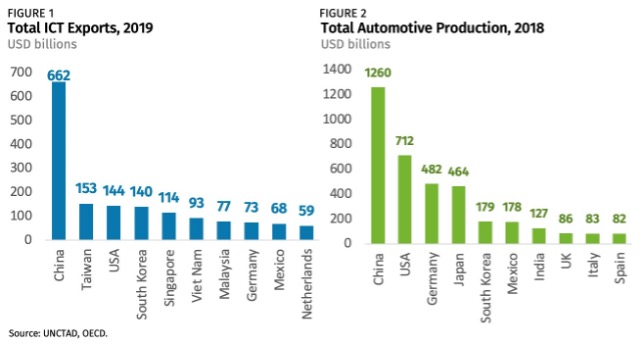Taiwan: At the Edge of Order
Taiwan and its contested position in shaping global power.
Nowhere is the future of international order more contested than over Taiwan, where the decline of American dominance meets the ascent of Chinese ambition. Though conflict is far from inevitable, both sides are increasingly prone to frame the Taiwan question in stark, zero-sum terms (Swaine, 2024). For Beijing, the issue is one of territorial integrity, with reunification seen as the natural conclusion of a century-long national revival (CSIS Interpret, 2000). In Washington, Taiwan has become a litmus test for American resolve and strategic leadership in the Indo-Pacific. Hence, against this backdrop, the risk of an all-out conflict remains very real. This article examines the future trajectory of U.S.–China relations over Taiwan, outlining plausible scenarios and weighing their implications for international commerce.
The Geopolitical Flashpoint
The incomplete resolution of China’s civil war in 1949—marked by the Communist victory on the mainland and the Nationalist withdrawal to Taiwan—created the structural conditions underlying territorial circumstances (CSIS Interpret, 2000). Meanwhile, Washington’s subsequent One China policy has sought to balance acknowledgment of Beijing’s sovereignty claims with unofficial support for Taiwan’s democratic development. This delicate equilibrium has grown increasingly unstable as U.S. preeminence wanes.
Under President Xi Jinping’s leadership, Beijing has escalated military pressure on Taiwan while Washington has correspondingly strengthened its commitment to the island’s self-defense capabilities (Gomez, 2024). This bilateral friction reflects a broader strategic competition in which US officials increasingly frame China’s rise as a fundamental challenge to the liberal international order and democratic governance itself (Blinken, 2022).
Measuring the Stakes

Therefore, a conflict over Taiwan would send shockwaves through the global economy. As shown in the data above, China and Taiwan together account for nearly $815 billion in ICT exports, anchoring critical segments of the global supply chain, from Taiwan’s advanced semiconductors (TSMC) to China’s role in assembly and midstream processing. Furthermore, disruptions would halt the flow of chips and components vital to everything from smartphones and electric vehicles to fighter jets. Moreover, China, as the world’s leading automotive manufacturing hub, would suffer internally, while global investors would likely retreat from Chinese markets. However, for businesses worldwide, the risk is not abstract; Taiwan sits at the heart of technological production and economic stability (Vest, Kratz, and Goujon, 2022).
Assessing the Risk of Conflict
Competing visions for Taiwan’s future reflect deeper uncertainties in U.S.–China relations. While open conflict is not inevitable, the strategic trajectory could take several plausible forms, each carrying distinct risks and implications.
- U.S.–China Détente: This scenario envisions a continued pattern of managed competition. Strategic rivalry persists across security, economic, technological, and ideological domains, but direct conflict is avoided through clear communication, crisis management, and mutual restraint. Thus, Taiwan remains a flashpoint, but tensions are contained as Beijing refrains from military escalation and Washington tempers its support for Taiwan’s strategic autonomy and military buildup (Swaine, 2022).
- Peaceful reunification: In this scenario, China’s steady economic rise and a gradual erosion of U.S. military primacy shift the regional balance of power. As Taiwan’s younger generation becomes more integrated into China’s economic and cultural orbit, momentum for independence wanes. Over time, political space narrows and cross-Strait ties deepen, paving the way for reunification without the use of force by mid-century (Kuosa, Stucki & Södergrann, 2023).
- All-Out-War: The most destabilising outcome sees China exploiting global distractions, such as conflicts in Ukraine or the Middle East, to launch a sudden, full-scale naval assault on Taiwan. The invasion prompts an urgent, complex response from regional and global actors. Moreover, the outcome hinges on the speed, scale, and coordination of international action. The resulting conflict would redefine the architecture of 21st-century geopolitics (Kuosa, Stucki & Södergrann, 2023).
Taiwan stands at the intersection of technological interdependence, great-power rivalry, and competing visions of global order. Therefore, as the United States and China navigate an era of strategic uncertainty, the island’s future will shape not only regional dynamics but the broader contours of international stability.
Whether the coming years bring coexistence, accommodation, or confrontation will depend as much on diplomacy and economic foresight as on military deterrence. Consequently, for global businesses, Taiwan is no longer a distant concern—it is a central fault line in the global economy, with direct implications for supply chains, capital flows, and strategic risk. Hence, in this environment, preparing for multiple scenarios is not just prudent; it is essential.
Bibliography
- Blinken, Antony. “The Administration’s Approach to the People’s Republic of China.” (Speech, Washington, D.C., May 26, 2022).
- Bush, R.C., 2017”A One-China Policy Primer, East Asia Policy Paper, The Brookings Institution, March 2017. Available at: Brookings Institution [Accessed 31 July 2025].
- CSIS Interpret. (1995) ‘The One-China Principle and the Taiwan Issue’, *Interpret.CSIS.org*. Published 1 February 1995. Available at: https://interpret.csis.org/translations/the-one-chinaprinciple-and-the-taiwan-issue/ (Accessed: 31 July 2025).
- Gomez, J., 2024. Philippines won’t invoke mutual defense treaty with US after Chinese
- confrontation at disputed shoal, AP News, 21 June 2024. Available at: AP News [Accessed 31 July 2025]. AP News
- Kuosa, T., Stucki, M. & Södergrann, H., 2023. Three scenarios on the future of Taiwan-China relations, Futures Platform, 15 December 2023. Available at: https://www.futuresplatform.com/ blog/scenarios-taiwan-china-relations-conflict [Accessed 31 July 2025]
- Medeiros, E.S., 2024. Scenarios for the U.S.–China Relationship: Reflections on “Positive but
- Realistic Futures”. In: C.S. Chivvis, ed. U.S.–China Relations for the 2030s: Toward a Realistic Scenario for Coexistence, Washington, D.C.: Carnegie Endowment for International Peace, pp. 19– X (Chapter 2).
- Swaine, M.D., 2022. Ending the Destructive Sino-U.S. Interaction Over Taiwan: A Call for Mutual Reassurance, Quincy Institute Brief No. 31, October 2022. Quincy Institute for Responsible Statecraft. Available at: Quincy Institute website [Accessed 31 July 2025].
- Swaine, M.D. (2024) How to Stop the United States and China from Sliding into War. War on the Rocks, 25 November. Available at: https://warontherocks.com/2024/11/how-to-stop-the-unitedstates-and-china-from-sliding-into-war/ (Accessed: 31 July 2025).
- Vest, C., Kratz, A. & Goujon, R. (2022) The Global Economic Disruptions from a Taiwan Conflict. Rhodium Group. Available at: rhg.com/research/taiwan-economic-disruptions/ (Accessed: 1 August 2025).



